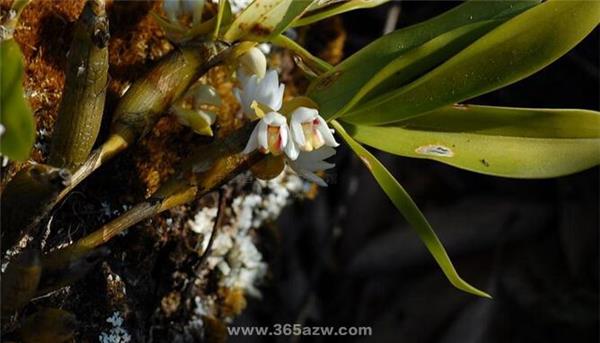Introduction to maintenance skills of yellow velvet woolly orchid
Cymbidium is a kind of plant of Orchidaceae. This paper lists the maintenance skills of Cymbidium, and the friends who cultivate it can be used as a reference to maintain their own Cymbidium.

Cymbidium pubescens is a plant of the genus Cymbidium of Orchidaceae, with well-developed rhizomes, flowering from April to May and fruiting from August to September. Epiphytic on trees or rocks at an altitude of 800m or 1500m.
Introduction to the shape of yellow plush orchid
The rhizome is well developed, ca. 5 mm in diameter, and there are 5 subfunnel-shaped membranous sheaths between the two pseudobulbs, which fall off when old; the pseudobulbs are elliptic, slightly compressed, 2 Mel 7 mm in length, 1.5 mi 2.5 mm in diameter, often with 2 mi 3 nodes, with 3 membranous sheaths at the base and 4 leaves at the tip. Leaves thicker, sometimes fleshy, elliptic or oblong-lanceolate, 10 mm long and 1 mi wide, apex acute, base attenuate, articulate; petiole ca. 1 Mel 1.5 m long.
Morphological characteristics of Cymbidium pubescens
Rhizome
The rhizome of Cymbidium pubescens is well developed, ca. 5 mm in diameter, with 4-5 subfunnel-shaped membranous sheaths between the two pseudobulbs, which fall off when old; pseudobulbs are elliptic, slightly compressed, 2-7 cm long, 1.5-2.5 mm thick, often with 2-3 nodes, with 2-3 membranous sheaths at the base and 3-4 leaves at the tip.
Leaf
Leaves of Cymbidium are thicker, sometimes fleshy, elliptic or oblong-lanceolate, 10-24 cm long and 1-5 cm wide, apex acute, base tapered, articulate; petiole ca. 1-1.5 cm long.
Flowers

The inflorescence of Cymbidium is stout, originating from the pseudobulb near the base, 10-30 cm long, above the leaf surface, densely yellowish brown tomentose (sparse when fruit hairs), 6-7 funnel-shaped sheaths at the base, with more than 10 or more flowers; bracts ovate or ovate-lanceolate, 1.2-2 cm long, apex acuminate, abaxially densely yellowish brown tomentose, sparsely pubescent Pedicel and ovary 3-4 cm long, densely yellowish brown tomentose; sepals abaxially densely yellowish brown tomentose, slightly thicker; middle sepals oblong-lanceolate, 10-15 mm long, ca. 3 mm wide, apex shortly acuminate; lateral sepals obliquely ovate-lanceolate, nearly as long as middle sepals, 4-5 mm wide, apex acuminate, base fully United with gynostele to form calyx sac.
The propagation mode of Cymbidium pubescens
Ramet propagation
Yellow velvet Cymbidium can be carried out in both spring and autumn, and it usually divides every three years. All plants with dense pseudocorms can be ramified, and at least 5 connected pseudocorms should be preserved in each clump. Irrigation should be reduced before splitting, so that the basin soil is better than. When putting on the basin after ramet, first cover the bottom hole of the basin with broken tiles, then cover with coarse stones, occupy the depth of the basin from 5 to 1, and then put coarse-grained soil and a small amount of fine soil, and then plant it with sandy loam rich in humus. Planting depth to the false bulb just buried in the soil strength, the edge of the basin left 2 meters along the mouth, covered with green cloud grass or fine stones, and finally watered thoroughly, placed in the shade for 10-15 days, keep the soil moist, gradually reduce watering, and carry out normal maintenance.

Disease control of Cymbidium pubescens
Sheath rust
Usually on the upper and lower surfaces of the leaves, there are fewer protruding vesicles on the stem, containing yellow, orange, rust, or even purplish-black powdery spores. The disease is not fatal and the leaves do not die, but it weakens the growth of the plant. In addition to cutting off diseased leaves, 65% Dysen zinc powder 500-600 times or copper-containing fungicides can be sprayed.
White silk disease
It mostly occurs in the mildew and rainy season. At the beginning of the disease, the leaf base was covered with white silk. Causing the roots to rot. Prevention and treatment: remove the basin soil with bacteria and sprinkle with pentachloronitrobenzene powder or lime. Radical cure: pay attention to ventilation and light transmission, basin soil drainage is good. Seriously diseased plants will be burned.
Anthrax
All the year round, the high temperature and rainy season is more rampant, and Jianlan is especially infected. The disease spot first extends from the leaf tip to the rhizome, which is brown at first, then gradually expands and increases, and many dry black spots appear, which in severe cases lead to the death of the whole plant. Prevention and treatment methods: in addition to actively changing the environmental conditions of Bodhisattva, during the onset period, 50% methyl topiramate wettable powder can be sprayed 1500 times, once every 7-10 days, and then supplemented with 1% equivalent Bordeaux solution, once every semimonthly, 3-5 times continuously.

Yellow plush blue maintenance skills are introduced here today, I hope you can enjoy the content of today's article.
Related
- Wuhan Hospital Iron Tree Blooming Result Was Instantly Frightened by the Gardener Master
- Which variety of camellia is the most fragrant and best? Which one do you like best?
- What is the small blue coat, the breeding methods and matters needing attention of the succulent plant
- Dormancy time and maintenance management of succulent plants during dormancy
- Minas succulent how to raise, Minas succulent plant pictures
- What are the varieties of winter succulent plants
- How to raise succulent plants in twelve rolls? let's take a look at some experience of breeding twelve rolls.
- Attention should be paid to water control for succulent plants during dormant period (winter and summer)
- Watering experience of twelve rolls of succulent plants
- Techniques for fertilizing succulent plants. An article will let you know how to fertilize succulent plants.



